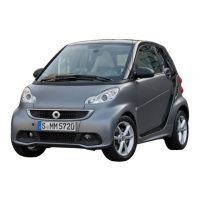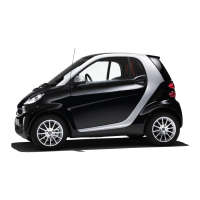G
WARNING
In the event of a vehicle fire, the internal
pressure of the high-voltage battery could
exceed a critical value. In this case, flam-
mable gas escapes through a vent valve in
the vehicle's underbody. The gas can
ignite. There is a risk of injury.
Leave the danger area immediately. Secure
the danger area at a suitable distance,
whilst observing legal requirements.
G
DANGER
Connecting the charging cable to the
mains supply via incorrectly installed
mains sockets or by means of adapters,
extension cables or similar could cause a
fire or an electric shock. There is a risk of
fatal injury.
To avoid hazardous situations, observe the
following:
R
Only connect the charging cable to
mains sockets:
-
which have been properly installed
and
-
which have been inspected by a quali-
fied electrician
R
For safety reasons, only use the charg-
ing cables supplied with the vehicle, or
charging cables which have been
approved for use with this vehicle.
R
Never use a damaged charging cable.
R
Do not use:
-
extension cables
-
extension reels
-
multiple sockets
R
Never use socket adapters to connect the
charging cable to the mains socket. The
only exception being if the adapter has
been tested and approved by the manu-
facturer for charging the high-voltage
battery of an electric vehicle.
R
Observe the safety notes in the operat-
ing instructions for the socket adapter.
G
DANGER
Connecting the charging cable to the wall-
box via an incorrectly installed wallbox or
by means of adapters, extension cables or
similar could cause a fire or an electric
shock. There is a risk of fatal injury.
To avoid such risks, observe the following:
R
Only connect the charging cable to a
wallbox:
-
which has been properly installed and
-
has been inspected by a qualified
electrician
R
For safety reasons, only use charging
cables which have been tested and
approved for charging the high-voltage
battery of an electric vehicle.
R
Never use damaged charging cables.
R
Do not connect the charging cable to an
amplifier.
R
Do not extend the charging cable.
R
Never use an adapter.
R
Observe the safety notes in the operat-
ing instructions for the wallbox.
G
DANGER
Charging the high-voltage battery with a
charging cable that does not function cor-
rectly could cause a fire or an electric
shock. There is a risk of fatal injury!
To avoid such risks, observe the following:
R
Ensure that there are no fluids or foreign
objects in the charging cable connector
or on the charging cable socket before
connecting the charging cable connec-
tor and the charging cable coupling.
R
Do not place the charging cable in water,
fluids or snow.
R
Check the charging cable for faults, e.g.
for damage to the charging cable con-
nector and the charging cable socket as
well as for cuts or tears in the cable
insulation.
70
Charging the high-voltage battery
>> Driving.

